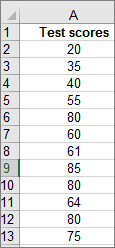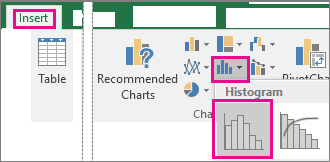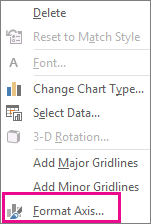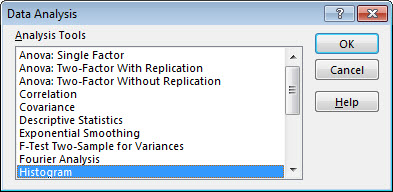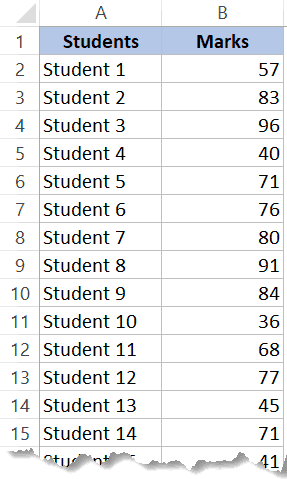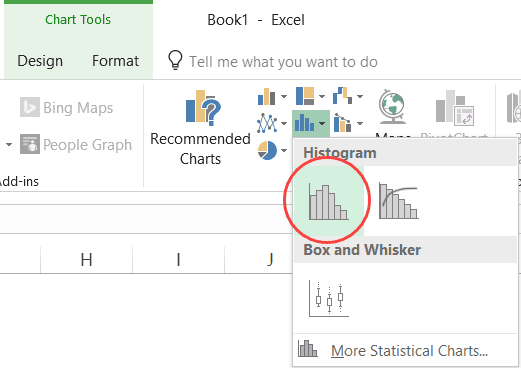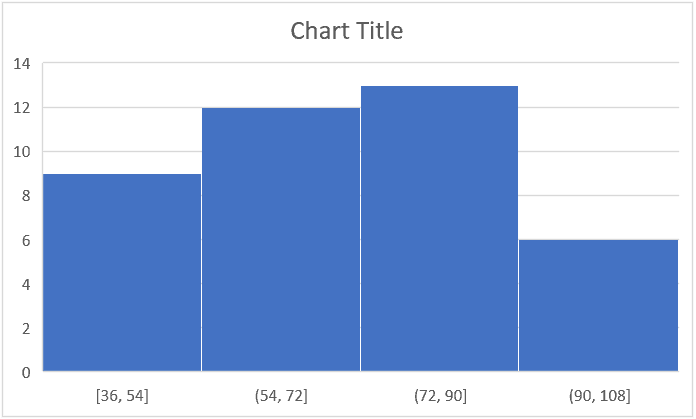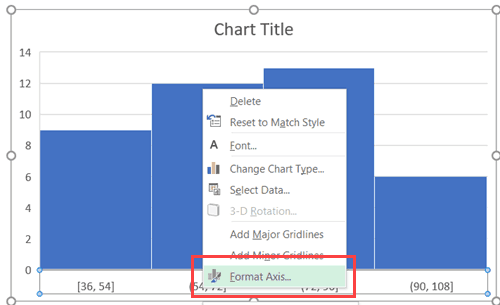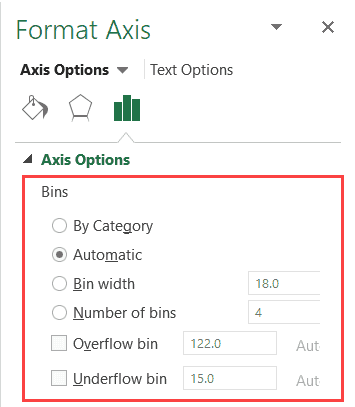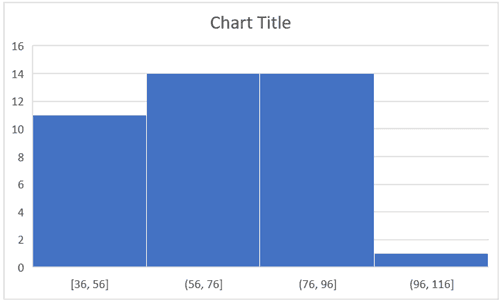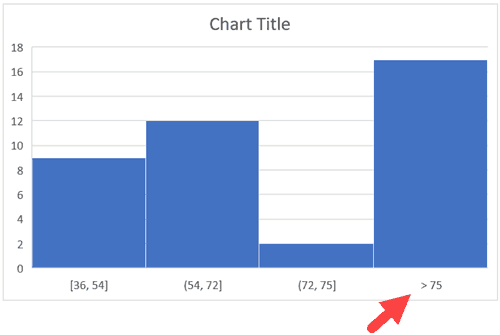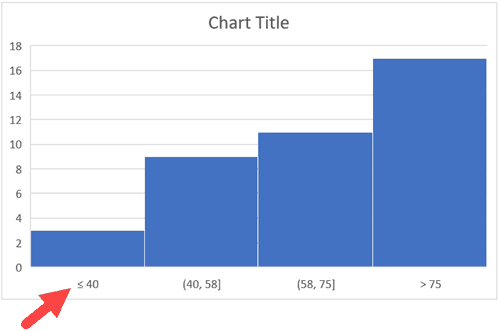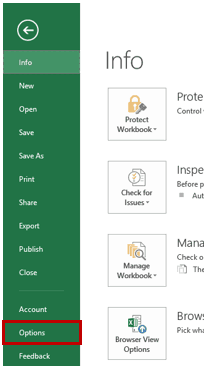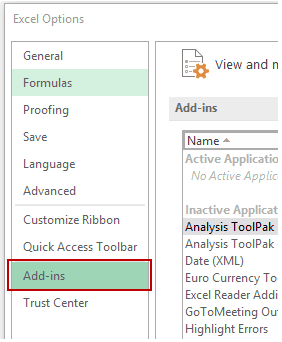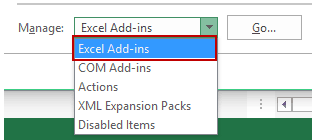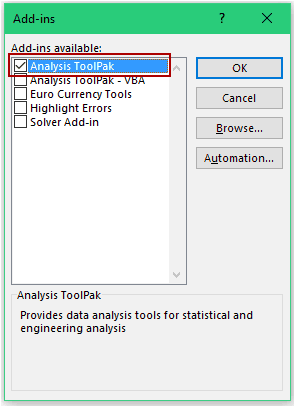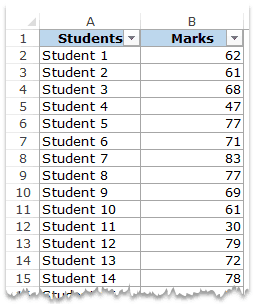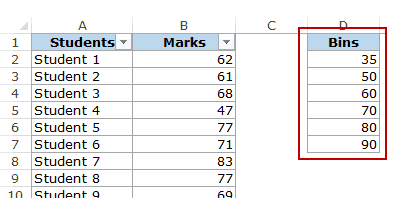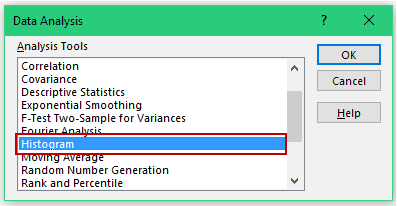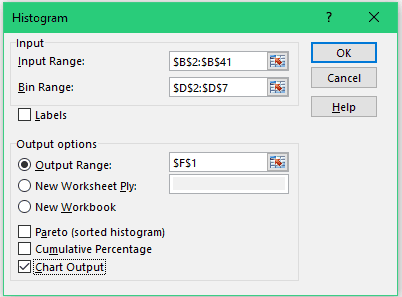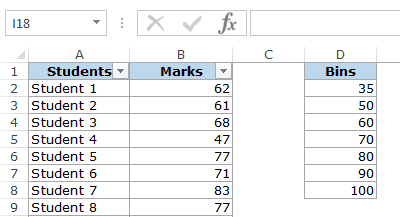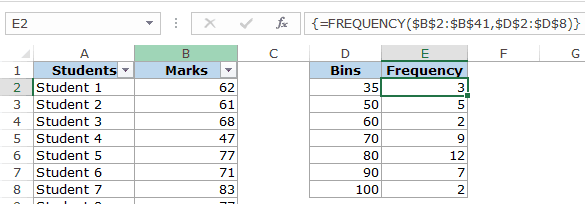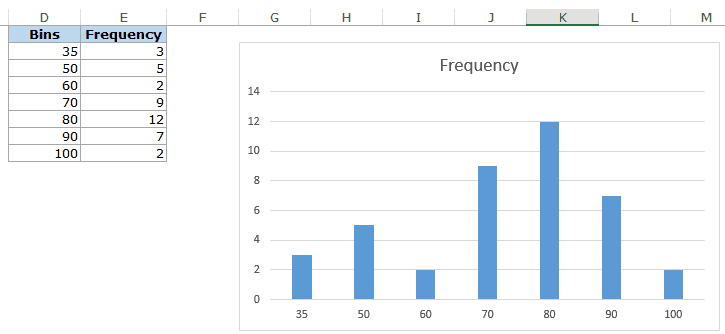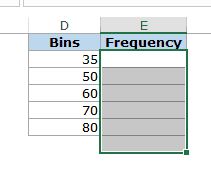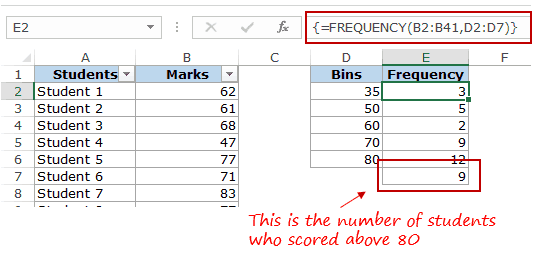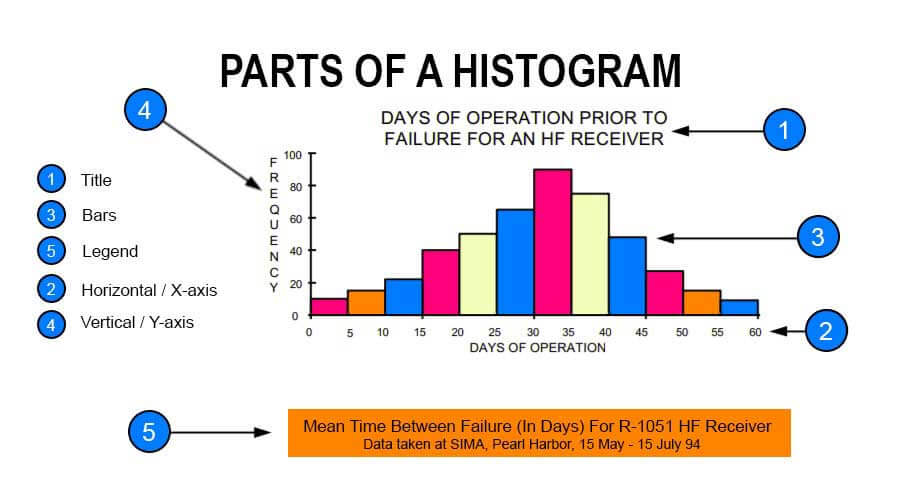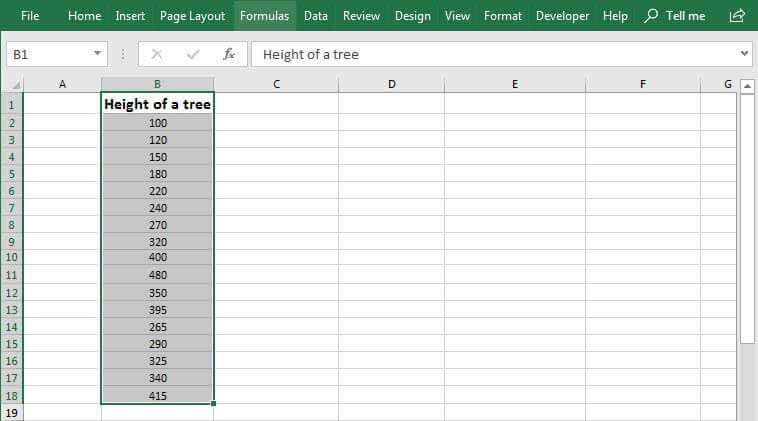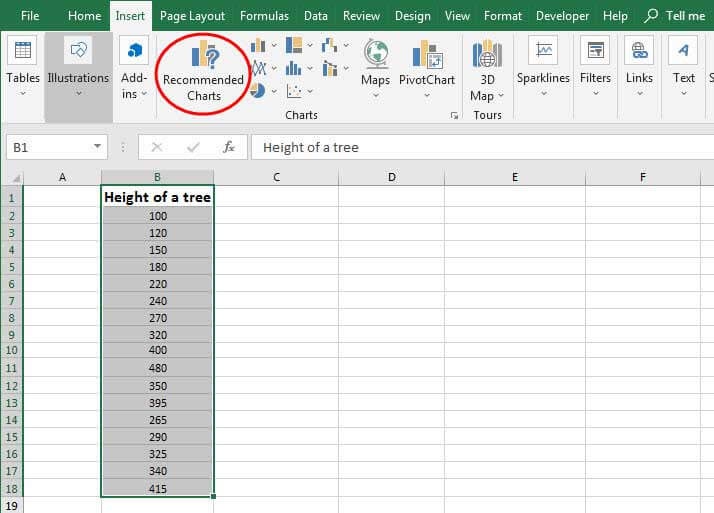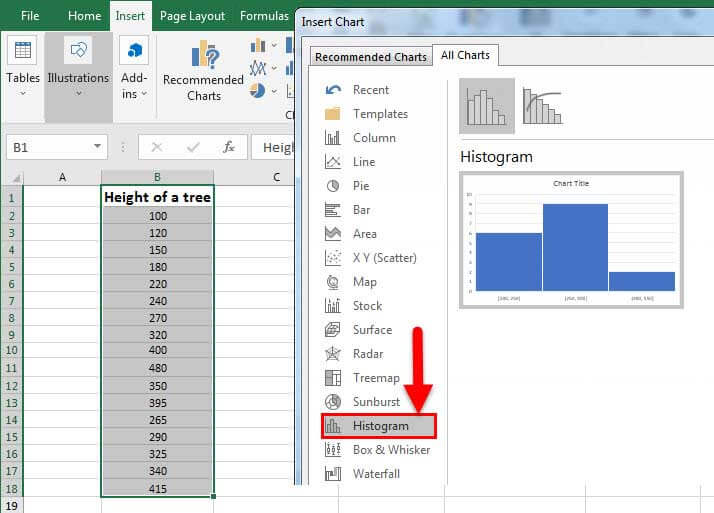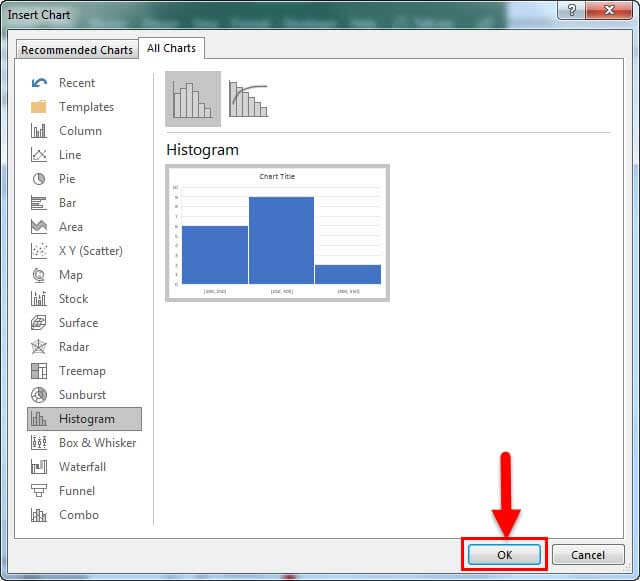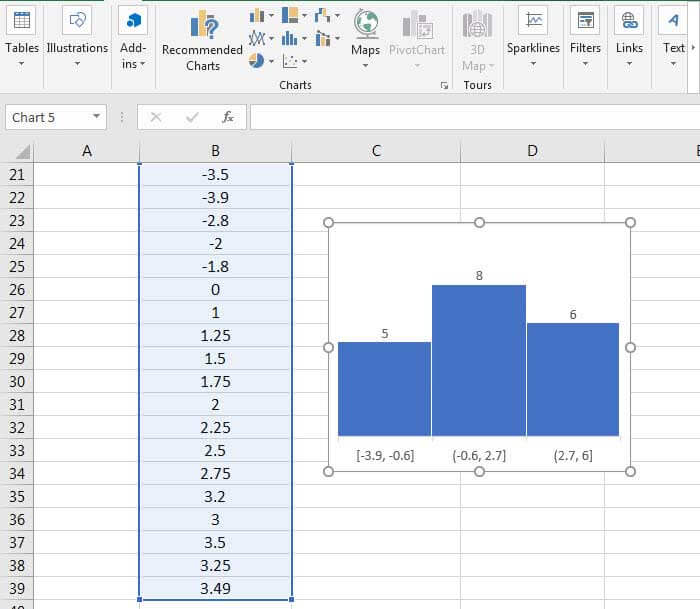Excel for Microsoft 365 Word for Microsoft 365 Outlook for Microsoft 365 PowerPoint for Microsoft 365 Excel for Microsoft 365 for Mac Word for Microsoft 365 for Mac Outlook for Microsoft 365 for Mac PowerPoint for Microsoft 365 for Mac Excel for the web Excel 2021 Word 2021 Outlook 2021 PowerPoint 2021 Excel 2021 for Mac Word 2021 for Mac Outlook 2021 for Mac PowerPoint 2021 for Mac Excel 2019 Word 2019 Outlook 2019 PowerPoint 2019 Excel 2019 for Mac Word 2019 for Mac Outlook 2019 for Mac PowerPoint 2019 for Mac Excel 2016 Word 2016 Outlook 2016 PowerPoint 2016 Excel 2016 for Mac Excel 2013 Excel for iPad Excel for iPhone Excel 2010 Excel 2007 More…Less
A histogram is a column chart that shows frequency data.
Note: This topic only talks about creating a histogram. For information on Pareto (sorted histogram) charts, see Create a Pareto chart.
-
Select your data.
(This is a typical example of data for a histogram.)
-
Click Insert > Insert Statistic Chart > Histogram.
You can also create a histogram from the All Charts tab in Recommended Charts.
Tips:
-
Use the Design and Format tabs to customize the look of your chart.
-
If you don’t see these tabs, click anywhere in the histogram to add the Chart Tools to the ribbon.

-
Right-click the horizontal axis of the chart, click Format Axis, and then click Axis Options.
-
Use the information in the following table to decide which options you want to set in the Format Axis task pane.
Option
Description
By Category
Choose this option when the categories (horizontal axis) are text-based instead of numerical. The histogram will group the same categories and sum the values in the value axis.
Tip: To count the number of appearances for text strings, add a column and fill it with the value “1”, then plot the histogram and set the bins to By Category.
Automatic
This is the default setting for histograms. The bin width is calculated using Scott’s normal reference rule.
Bin width
Enter a positive decimal number for the number of data points in each range.
Number of bins
Enter the number of bins for the histogram (including the overflow and underflow bins).
Overflow bin
Select this check box to create a bin for all values above the value in the box to the right. To change the value, enter a different decimal number in the box.
Underflow bin
Select this check box to create a bin for all values below or equal to the value in the box to the right. To change the value, enter a different decimal number in the box.
Automatic option (Scott’s normal reference rule)
Scott’s normal reference rule tries to minimize the bias in variance of the histogram compared with the data set, while assuming normally distributed data.
Overflow bin option
Underflow bin option

-
Make sure you have loaded the Analysis ToolPak. For more information, see Load the Analysis ToolPak in Excel.
-
On a worksheet, type the input data in one column, adding a label in the first cell if you want.
Be sure to use quantitative numeric data, like item amounts or test scores. The Histogram tool won’t work with qualitative numeric data, like identification numbers entered as text.
-
In the next column, type the bin numbers in ascending order, adding a label in the first cell if you want.
It’s a good idea to use your own bin numbers because they may be more useful for your analysis. If you don’t enter any bin numbers, the Histogram tool will create evenly distributed bin intervals by using the minimum and maximum values in the input range as start and end points.
-
Click Data > Data Analysis.
-
Click Histogram > OK.
-
Under Input, do the following:
-
In the Input Range box, enter the cell reference for the data range that has the input numbers.
-
In the Bin Range box, enter the cell reference for the range that has the bin numbers.
If you used column labels on the worksheet, you can include them in the cell references.
Tip: Instead of entering references manually, you can click
to temporarily collapse the dialog box to select the ranges on the worksheet. Clicking the button again expands the dialog box.
-
-
If you included column labels in the cell references, check the Labels box.
-
Under Output options, choose an output location.
You can put the histogram on the same worksheet, a new worksheet in the current workbook, or in a new workbook.
-
Check one or more of the following boxes:
Pareto (sorted histogram) This shows the data in descending order of frequency.
Cumulative Percentage
This shows cumulative percentages and adds a cumulative percentage line to the histogram chart.
Chart Output
This shows an embedded histogram chart. -
Click OK.
If you want to customize your histogram, you can change text labels, and click anywhere in the histogram chart to use the Chart Elements, Chart Styles, and Chart Filter buttons on the right of the chart.
-
Select your data.
(This is a typical example of data for a histogram.)
-
Click Insert > Chart.
-
In the Insert Chart dialog box, under All Charts, click Histogram , and click OK.
Tips:
-
Use the Design and Format tabs on the ribbon to customize the look of your chart.
-
If you don’t see these tabs, click anywhere in the histogram to add the Chart Tools to the ribbon.

-
Right-click the horizontal axis of the chart, click Format Axis, and then click Axis Options.
-
Use the information in the following table to decide which options you want to set in the Format Axis task pane.
Option
Description
By Category
Choose this option when the categories (horizontal axis) are text-based instead of numerical. The histogram will group the same categories and sum the values in the value axis.
Tip: To count the number of appearances for text strings, add a column and fill it with the value “1”, then plot the histogram and set the bins to By Category.
Automatic
This is the default setting for histograms.
Bin width
Enter a positive decimal number for the number of data points in each range.
Number of bins
Enter the number of bins for the histogram (including the overflow and underflow bins).
Overflow bin
Select this check box to create a bin for all values above the value in the box to the right. To change the value, enter a different decimal number in the box.
Underflow bin
Select this check box to create a bin for all values below or equal to the value in the box to the right. To change the value, enter a different decimal number in the box.
Follow these steps to create a histogram in Excel for Mac:
-
Select the data.
(This is a typical example of data for a histogram.)
-
On the ribbon, click the Insert tab, then click
(Statistical icon) and under Histogram, select Histogram.
Tips:
-
Use the Chart Design and Format tabs to customize the look of your chart.
-
If you don’t see the Chart Design and Format tabs, click anywhere in the histogram to add them to the ribbon.
To create a histogram in Excel 2011 for Mac, you’ll need to download a third-party add-in. See: I can’t find the Analysis Toolpak in Excel 2011 for Mac for more details.
In Excel Online, you can view a histogram (a column chart that shows frequency data), but you can’t create it because it requires the Analysis ToolPak, an Excel add-in that isn’t supported in Excel for the web.
If you have the Excel desktop application, you can use the Edit in Excel button to open Excel on your desktop and create the histogram.

-
Tap to select your data.
-
If you’re on a phone, tap the edit icon
to show the ribbon. and then tap Home.
-
Tap Insert > Charts > Histogram.
If necessary, you can customize the elements of the chart.
-
Tap to select your data.
-
If you’re on a phone, tap the edit icon
to show the ribbon, and then tap Home.
-
Tap Insert > Charts > Histogram.
To create a histogram in Excel, you provide two types of data — the data that you want to analyze, and the bin numbers that represent the intervals by which you want to measure the frequency. You must organize the data in two columns on the worksheet. These columns must contain the following data:
-
Input data This is the data that you want to analyze by using the Histogram tool.
-
Bin numbers These numbers represent the intervals that you want the Histogram tool to use for measuring the input data in the data analysis.
When you use the Histogram tool, Excel counts the number of data points in each data bin. A data point is included in a particular bin if the number is greater than the lowest bound and equal to or less than the greatest bound for the data bin. If you omit the bin range, Excel creates a set of evenly distributed bins between the minimum and maximum values of the input data.
The output of the histogram analysis is displayed on a new worksheet (or in a new workbook) and shows a histogram table and a column chart that reflects the data in the histogram table.
Need more help?
You can always ask an expert in the Excel Tech Community or get support in the Answers community.
See Also
Create a waterfall chart
Create a Pareto chart
Create a sunburst chart in Office
Create a box and whisker chart
Create a treemap chart in Office
Need more help?
Watch Video – 3 Ways to Create a Histogram Chart in Excel
A histogram is a common data analysis tool in the business world. It’s a column chart that shows the frequency of the occurrence of a variable in the specified range.
According to Investopedia, a Histogram is a graphical representation, similar to a bar chart in structure, that organizes a group of data points into user-specified ranges. The histogram condenses a data series into an easily interpreted visual by taking many data points and grouping them into logical ranges or bins.
A simple example of a histogram is the distribution of marks scored in a subject. You can easily create a histogram and see how many students scored less than 35, how many were between 35-50, how many between 50-60 and so on.
There are different ways you can create a histogram in Excel:
- If you’re using Excel 2016, there is an in-built histogram chart option that you can use.
- If you’re using Excel 2013, 2010 or prior versions (and even in Excel 2016), you can create a histogram using Data Analysis Toolpack or by using the FREQUENCY function (covered later in this tutorial)
Let’s see how to make a Histogram in Excel.
Creating a Histogram in Excel 2016
Excel 2016 got a new addition in the charts section where a histogram chart was added as an inbuilt chart.
In case you’re using Excel 2013 or prior versions, check out the next two sections (on creating histograms using Data Analysis Toopack or Frequency formula).
Suppose you have a dataset as shown below. It has the marks (out of 100) of 40 students in a subject.
Here are the steps to create a Histogram chart in Excel 2016:
- Select the entire dataset.
- Click the Insert tab.
- In the Charts group, click on the ‘Insert Static Chart’ option.
- In the HIstogram group, click on the Histogram chart icon.
The above steps would insert a histogram chart based on your data set (as shown below).
Now you can customize this chart by right-clicking on the vertical axis and selecting Format Axis.
This will open a pane on the right with all the relevant axis options.
Here are some of the things you can do to customize this histogram chart:
- By Category: This option is used when you have text categories. This could be useful when you have repetitions in categories and you want to know the sum or count of the categories. For example, if you have sales data for items such as Printer, Laptop, Mouse, and Scanner, and you want to know the total sales of each of these items, you can use the By Category option. It isn’t helpful in our example as all our categories are different (Student 1, Student 2, Student3, and so on.)
- Automatic: This option automatically decides what bins to create in the Histogram. For example, in our chart, it decided that there should be four bins. You can change this by using the ‘Bin Width/Number of Bins’ options (covered below).
- Bin Width: Here you can define how big the bin should be. If I enter 20 here, it will create bins such as 36-56, 56-76, 76-96, 96-116.
- Number of Bins: Here you can specify how many bins you want. It will automatically create a chart with that many bins. For example, if I specify 7 here, it will create a chart as shown below. At a given point, you can either specify Bin Width or Number of Bins (not both).
- Overflow Bin: Use this bin if you want all the values above a certain value clubbed together in the Histogram chart. For example, if I want to know the number of students that have scored more than 75, I can enter 75 as the Overflow Bin value. It will show me something as shown below.
- Underflow Bin: Similar to Overflow Bin, if I want to know the number of students that have scored less than 40, I can enter 4o as the value and show a chart as shown below.
Once you have specified all the settings and have the histogram chart you want, you can further customize it (changing the title, removing gridlines, changing colors, etc.)
Creating a Histogram Using Data Analysis Tool pack
The method covered in this section will also work for all the versions of Excel (including 2016). However, if you’re using Excel 2016, I recommend you use the inbuilt histogram chart (as covered below)
To create a histogram using Data Analysis tool pack, you first need to install the Analysis Toolpak add-in.
This add-in enables you to quickly create the histogram by taking the data and data range (bins) as inputs.
Installing the Data Analysis Tool Pack
To install the Data Analysis Toolpak add-in:
- Click the File tab and then select ‘Options’.
- In the Excel Options dialog box, select Add-ins in the navigation pane.
- In the Manage drop-down, select Excel Add-ins and click Go.
- In the Add-ins dialog box, select Analysis Toolpak and click OK.
This would install the Analysis Toolpak and you can access it in the Data tab in the Analysis group.
Creating a Histogram using Data Analysis Toolpak
Once you have the Analysis Toolpak enabled, you can use it to create a histogram in Excel.
Suppose you have a dataset as shown below. It has the marks (out of 100) of 40 students in a subject.
To create a histogram using this data, we need to create the data intervals in which we want to find the data frequency. These are called bins.
With the above dataset, the bins would be the marks intervals.
You need to specify these bins separately in an additional column as shown below:
Now that we have all the data in place, let’s see how to create a histogram using this data:
- Click the Data tab.
- In the Analysis group, click on Data Analysis.
- In the ‘Data Analysis’ dialog box, select Histogram from the list.
- Click OK.
- In the Histogram dialog box:
- Select the Input Range (all the marks in our example)
- Select the Bin Range (cells D2:D7)
- Leave the Labels checkbox unchecked (you need to check it if you included labels in the data selection).
- Specify the Output Range if you want to get the Histogram in the same worksheet. Else, choose New Worksheet/Workbook option to get it in a separate worksheet/workbook.
- Select Chart Output.
- Click OK.
This would insert the frequency distribution table and the chart in the specified location.
Now there are some things you need to know about the histogram created using the Analysis Toolpak:
- The first bin includes all the values below it. In this case, 35 shows 3 values indicating that there are three students who scored less than 35.
- The last specified bin is 90, however, Excel automatically adds another bin – More. This bin would include any data point which lies after the last specified bin. In this example, it means that there are 2 students who have scored more than 90.
- Note that even if I add the last bin as 100, this additional bin would still be created.
- This creates a static histogram chart. Since Excel creates and pastes the frequency distribution as values, the chart would not update when you change the underlying data. To refresh it, you’ll have to create the histogram again.
- The default chart is not always in the best format. You can change the formatting like any other regular chart.
- Once created, you can not use Control + Z to revert it. You’ll have to manually delete the table and the chart.
If you create a histogram without specifying the bins (i.e., you leave the Bin Range empty), it would still create the histogram. It would automatically create six equally spaced bins and used this data to create the histogram.
Creating a Histogram using FREQUENCY Function
If you want to create a histogram that is dynamic (i.e., updates when you change the data), you need to resort to formulas.
In this section, you’ll learn how to use the FREQUENCY function to create a dynamic histogram in Excel.
Again, taking the student’s marks data, you need to create the data intervals (bins) in which you want to show the frequency.
Here is the function that will calculate the frequency for each interval:
=FREQUENCY(B2:B41,D2:D8)
Since this is an array formula, you need to use Control + Shift + Enter, instead of just Enter.
Here are the steps to make sure you get the correct result:
- Select all cells adjacent to the bins. In this case, these are E2:E8.
- Press F2 to get into the edit mode for cell E2.
- Enter the frequency formula: =FREQUENCY(B2:B41,D2:D8)
- Hit Control + Shift + Enter.
With the result that you get, you can now create a histogram (which is nothing but a simple column chart).
Here are some important things you need to know when using the FREQUENCY function:
- The result is an array and you can not delete a part of the array. If you need to, delete all the cells that have the frequency function.
- When a bin is 35, the frequency function would return a result that includes 35. So 35 means score up to 35, and 50 would mean score more than 35 and up to 50.
Also, let’s say you want to have the specified data intervals till 80, and you want to group all the result above 80 together, you can do that using the FREQUENCY function. In that case, select one more cell than the number of bins. For example, if you have 5 bins, then select 6 cells as shown below:
FREQUENCY function would automatically calculate all the values above 80 and return the count.
You May Also Like the Following Excel Tutorials:
- Creating a Pareto Chart in Excel.
- Creating a Gantt Chart in Excel.
- Creating a Milestone Chart in Excel.
- How to Make a Bell Curve in Excel.
- How to Create a Bullet Chart in Excel.
- How to Create a Heat Map in Excel.
- Standard Deviation in Excel.
- Area Chart in Excel.
- Advanced Excel Charts.
- Creating Excel Dashboards.
Содержание
- Create a histogram
- Need more help?
- Histogram Excel Chart
- Histogram in Excel
- Purpose of a Histogram in Excel
- How to Make a Histogram Chart in Excel?
- Different shapes of Histogram Chart in Excel
- Steps to Create a Histogram in Excel
- Examples
- Example #1 – Height of Apple Trees
- Example #2 – Set of Negative and Positive Values
- Things to Remember
- Histogram Excel Chart Video
- Recommended Articles
Create a histogram
A histogram is a column chart that shows frequency data.
Note: This topic only talks about creating a histogram. For information on Pareto (sorted histogram) charts, see Create a Pareto chart.
- Which version/product are you using?
- Excel 2016 and newer versions
- Excel 2007 — 2013
- Outlook, PowerPoint, Word 2016
Select your data.
(This is a typical example of data for a histogram.)
Click Insert > Insert Statistic Chart > Histogram.
You can also create a histogram from the All Charts tab in Recommended Charts.
Use the Design and Format tabs to customize the look of your chart.
If you don’t see these tabs, click anywhere in the histogram to add the Chart Tools to the ribbon.
Right-click the horizontal axis of the chart, click Format Axis, and then click Axis Options.
Use the information in the following table to decide which options you want to set in the Format Axis task pane.
Choose this option when the categories (horizontal axis) are text-based instead of numerical. The histogram will group the same categories and sum the values in the value axis.
Tip: To count the number of appearances for text strings, add a column and fill it with the value “1”, then plot the histogram and set the bins to By Category.
This is the default setting for histograms. The bin width is calculated using Scott’s normal reference rule.
Enter a positive decimal number for the number of data points in each range.
Enter the number of bins for the histogram (including the overflow and underflow bins).
Select this check box to create a bin for all values above the value in the box to the right. To change the value, enter a different decimal number in the box.
Select this check box to create a bin for all values below or equal to the value in the box to the right. To change the value, enter a different decimal number in the box.
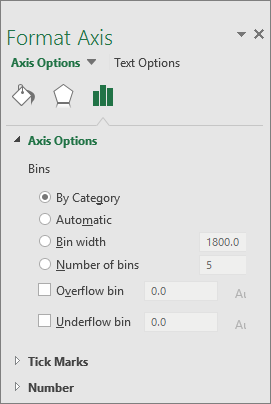
Tip: To read more about the histogram chart and how it helps you visualize statistical data, see this blog post on the histogram, Pareto, and box and whisker chart by the Excel team. You may also be interested learning more about the other new chart types described in this blog post.
Automatic option (Scott’s normal reference rule)
Scott’s normal reference rule tries to minimize the bias in variance of the histogram compared with the data set, while assuming normally distributed data.
Overflow bin option
Underflow bin option
Make sure you have loaded the Analysis ToolPak. For more information, see Load the Analysis ToolPak in Excel.
On a worksheet, type the input data in one column, adding a label in the first cell if you want.
Be sure to use quantitative numeric data, like item amounts or test scores. The Histogram tool won’t work with qualitative numeric data, like identification numbers entered as text.
In the next column, type the bin numbers in ascending order, adding a label in the first cell if you want.
It’s a good idea to use your own bin numbers because they may be more useful for your analysis. If you don’t enter any bin numbers, the Histogram tool will create evenly distributed bin intervals by using the minimum and maximum values in the input range as start and end points.
Click Data > Data Analysis.
Click Histogram > OK.
Under Input, do the following:
In the Input Range box, enter the cell reference for the data range that has the input numbers.
In the Bin Range box, enter the cell reference for the range that has the bin numbers.
If you used column labels on the worksheet, you can include them in the cell references.
Tip: Instead of entering references manually, you can click 
If you included column labels in the cell references, check the Labels box.
Under Output options, choose an output location.
You can put the histogram on the same worksheet, a new worksheet in the current workbook, or in a new workbook.
Check one or more of the following boxes:
Pareto (sorted histogram) This shows the data in descending order of frequency.
Cumulative Percentage This shows cumulative percentages and adds a cumulative percentage line to the histogram chart.
Chart Output This shows an embedded histogram chart.
If you want to customize your histogram, you can change text labels, and click anywhere in the histogram chart to use the Chart Elements, Chart Styles, and Chart Filter buttons on the right of the chart.
Select your data.
(This is a typical example of data for a histogram.)
Click Insert > Chart.
In the Insert Chart dialog box, under All Charts, click Histogram , and click OK.
Use the Design and Format tabs on the ribbon to customize the look of your chart.
If you don’t see these tabs, click anywhere in the histogram to add the Chart Tools to the ribbon.
Right-click the horizontal axis of the chart, click Format Axis, and then click Axis Options.
Use the information in the following table to decide which options you want to set in the Format Axis task pane.
Choose this option when the categories (horizontal axis) are text-based instead of numerical. The histogram will group the same categories and sum the values in the value axis.
Tip: To count the number of appearances for text strings, add a column and fill it with the value “1”, then plot the histogram and set the bins to By Category.
This is the default setting for histograms.
Enter a positive decimal number for the number of data points in each range.
Enter the number of bins for the histogram (including the overflow and underflow bins).
Select this check box to create a bin for all values above the value in the box to the right. To change the value, enter a different decimal number in the box.
Select this check box to create a bin for all values below or equal to the value in the box to the right. To change the value, enter a different decimal number in the box.

Follow these steps to create a histogram in Excel for Mac:
Select the data.
(This is a typical example of data for a histogram.)
On the ribbon, click the Insert tab, then click 
Use the Chart Design and Format tabs to customize the look of your chart.
If you don’t see the Chart Design and Format tabs, click anywhere in the histogram to add them to the ribbon.
To create a histogram in Excel 2011 for Mac, you’ll need to download a third-party add-in. See: I can’t find the Analysis Toolpak in Excel 2011 for Mac for more details.
In Excel Online, you can view a histogram (a column chart that shows frequency data), but you can’t create it because it requires the Analysis ToolPak, an Excel add-in that isn’t supported in Excel for the web.
If you have the Excel desktop application, you can use the Edit in Excel button to open Excel on your desktop and create the histogram.
Tap to select your data.
If you’re on a phone, tap the edit icon 
Tap Insert > Charts > Histogram.
If necessary, you can customize the elements of the chart.
Note: This feature is only available if you have a Microsoft 365 subscription. If you are a Microsoft 365subscriber, make sure you have the latest version of Office.
Tap to select your data.
If you’re on a phone, tap the edit icon 
Tap Insert > Charts > Histogram.
To create a histogram in Excel, you provide two types of data — the data that you want to analyze, and the bin numbers that represent the intervals by which you want to measure the frequency. You must organize the data in two columns on the worksheet. These columns must contain the following data:
Input data This is the data that you want to analyze by using the Histogram tool.
Bin numbers These numbers represent the intervals that you want the Histogram tool to use for measuring the input data in the data analysis.
When you use the Histogram tool, Excel counts the number of data points in each data bin. A data point is included in a particular bin if the number is greater than the lowest bound and equal to or less than the greatest bound for the data bin. If you omit the bin range, Excel creates a set of evenly distributed bins between the minimum and maximum values of the input data.
The output of the histogram analysis is displayed on a new worksheet (or in a new workbook) and shows a histogram table and a column chart that reflects the data in the histogram table.
Need more help?
You can always ask an expert in the Excel Tech Community or get support in the Answers community.
Источник
Histogram Excel Chart
Histogram in Excel
A histogram Excel chart is a data analysis chart used to represent histogram data. In Excel 2016 and older versions, this chart is built-in in Excel. While for previous versions, we used to make this chart manually by using the cumulative frequency method. In the histogram chart, the data comparison is classified into ranges.
In layman’s terms, it is a graphical representation of data using bars of different heights. For example, a histogram chart in Excel is like a bar chart except that it groups numbers into ranges, unlike individual values in a bar chart.
A histogram in Excel comprises five parts: “Title,” “Horizontal,” “Bars” (height and width), “Vertical,” and “Legend.”
- The title describes the information about the histogram.
- (Horizontal) X-axis grouped intervals (and not the individual points).
- Bars have a height and width. The height represents the number of times the set of values within an interval occurred. The width represents the length of the interval covered by the bar.
- (Vertical) Y-axis is the scale that shows you the frequency of the values within an interval.
- Legend describes additional information about the measurements.
Refer to the image given below to understand better. It shows a sample histogram with each component highlighted.
Table of contents
You are free to use this image on your website, templates, etc., Please provide us with an attribution link How to Provide Attribution? Article Link to be Hyperlinked
For eg:
Source: Histogram Excel Chart (wallstreetmojo.com)
Purpose of a Histogram in Excel
The purpose of the histogram chart in Excel is to roughly assess the probability distribution of a given variable by showing the frequencies of observations occurring in a certain range of values.
How to Make a Histogram Chart in Excel?
- Divide the entire range of values into a series of intervals.
- Count how many values fall into each interval.
- The buckets are generally specified as consecutive, non-overlapping intervals of a variable. They must be adjacent and may be of equal size.
- As the adjacent bins are continuous without gaps, the rectangles of a histogram touch each other to indicate that the original variable is continuous.
Different shapes of Histogram Chart in Excel
- Bell-shaped
- Bimodal
- Skewed right
- Skewed left
- Uniform
- Random
Steps to Create a Histogram in Excel
Following are the steps to create a histogram in Excel:
- The first step to building a histogram in Excel is to select the range of cells containing the data to be presented using the histogram. Then, it would be the input for the histogram.
Click on “Recommended Charts,” as shown in the below figure.
Select “Histogram” from the presented list.
Examples
A histogram chart in Excel is simple and easy to use. Let us understand working with some examples.
Example #1 – Height of Apple Trees
As shown in the above figure screenshot, the data is about the height of apple trees. The total number of trees is 17. The X-axis of the histogram in Excel shows the height range in cm. The Y-axis indicates trees. The chart shows three bars. One for the range 100-250 cm, the second for the range of 250-400, and the third for the range 400 – 550. So, the width of a bar is 150. So, the readings are in cm. The vertical axis (Y) shows the number of trees under a given range. E.g6 trees are in the range 100-250, 9 trees are in the range 250-400, and 2 trees are in the range 400-550. The legend is the height of the tree represented by green color. So, the bars indicate different heights in cm for the recorded trees.
Example #2 – Set of Negative and Positive Values
As shown in the above example, the dataset contains positive and negative values. Here also, Excel auto-calculated the range, which is 3.3. The total number of values in the dataset is 19. The 3 bars indicate three different ranges and the total number of input values falling under each range. 5 values are [-3.9, -0.6], 8 values range from -0.6 to 2.7, and 6 values range from 2.7 to 6.
- The histogram chart in Excel is useful where the entities to be measured can be presented in ranges such as height, weight, scales, frequencies, etc.
- They give a rough idea of the density of the underlying data distribution and often for density estimation.
- They are also used to estimate the underlying variable’s probability density function.
- Different intervals can expose various features of the input data in the histogram in Excel.
- A histogram chart in Excel can present data that is misleading.
- Too many blocks can make your analysis tough, while a few can miss out on important data.
- A histogram in Excel is not useful for showcasing discrete/categorized entities.
Things to Remember
- The histograms are based on the area and not the height of bars.
- It is a column-based chart that shows frequency data and is useful for depicting continuous data.
- While working on the histograms, one must ensure that the bins are not too small or too large. However, doing so might lead to incorrect observations.
- There is no “ideal” number of bins, and different bin sizes reveal various data features.
- The number of bins k can be assigned directly or can be calculated from a suggested bin width that has:

Histogram Excel Chart Video
Recommended Articles
This article is a guide to Histogram Chart in Excel. Here, we discuss its uses and how to create a histogram in Excel, along with Excel examples and downloadable Excel templates. You may also look at these useful functions in Excel: –
Источник
How to Make a Histogram in Excel – and Adjust Bin Size (2023)
We love how simple it is to create charts in Excel.
Like all others, making a histogram in Excel is similarly easy and fun. It helps you with data analysis, frequency distribution, and much more. 🎯
You can plot your data (very large ones, too) into a histogram in literally under a few seconds.
To learn what is a histogram, and how can you make and edit it in different ways – continue reading the article below.
Download our free sample workbook here to get your hands on a dataset to practice.
What is a histogram?
Before we narrate long and wordy definitions of what a histogram is, let’s just see what it looks like.

Safe to say a histogram is more like a column/bar chart with each bar representing some numerical data. 📶
In a histogram, each bar represents a certain range for example 1-10, 11- 20, and so on. Excel calls this graphical representation of ranges ‘bins’.
On the y-axis (vertical axis), we plot the number of occurrences of that range in our dataset. Each bar represents the number of data points we have for each range in our data set.
How to create a histogram in Excel
Making a histogram in Excel is surprisingly easy as Excel offers an in-built histogram chart type.
To quickly see how you can make one, consider the data below.

We have a group of children of different ages. A histogram can help us subgroup them based on their ages.
- Select the dataset.

- Go to the Insert Tab > Charts > Recommended Charts.

- Select the tab “All Charts”.

- Click on “Histogram” and choose the first chart type.

And here comes a histogram for your data.

Excel has plotted age groups ( 7 to 17 years, 18 to 28 years, and so on) on the x-axis. The numbers are allocated on the y-axis.
The first bar (for 7 to 17 years) touches 2 on the y-axis. This tells that our dataset has 2 people that fall within this age range.
Kevin (15 years old) and Betty (7 years old). 👩🏼🤝👩🏼

And so, you can readily see how many people we have in each age range.
Pro Tip!
You can also create a histogram chart through Excel’s Analysis Toolpak kit.
You can access it under the Data Tab > Analysis Group > Data analysis.
How to adjust bin sizes/intervals
Excel calls the range (like the age range 7 to 17 years) a bin. This bin size (age range) doesn’t necessarily have to be 10 years. You can set it to any interval – 15, 20, 30, or any number of years.
But how can you do that? Learn it here.
The above graph has the bin size set to 10. To change the bin size:
- Double-click on the graph. This will launch the Format pane to the right of your worksheet.
- Go to Horizontal Axis from the drop-down menu of options as shown below.

- Click on the icon for Axis.

Here you have the option for Bin Width.
- Change it to any value as desired.
For example, let’s set it to 15.

Your histogram takes a whole new look like that.
Note how the bin sizes (age ranges) have now changed to 7 to 22 years, 22 to 37 years, and so on.
Why does the range start from 7 only and not a round number like maybe 5 or 0? 🤔
Take a quick look at our data set for this histogram. The smallest data point (age) that we have is 7, and so, that is where the range starts.
Adjust the Number of Bins
In addition to the Bin size, you can also adjust the number of bins.
In this case, you fix the number of bins (bars) that you need on the graph, and Excel calculates the bin size itself.
- To do so, check the option for “Number of Bins”.
- Set the “Number of Bins” to any number.
We have set it to 6.

And there you have 6 bins to your graph now. Excel has automatically set the bin size to 10.1666.
But the bin size on the horizontal axis is now weird. Excel has taken the decimal places too far.
- To adjust this, go to the Number menu just below.
- Set the category to “Numbers”.
- Turn the decimal places to 0 or any number as desired.

And you have your bin sizes adjusted.
How to add/remove spacing between bars
The histogram bars do not necessarily have to be of a certain width under the default chart type.
You can change the gap between bars (which will change the bin width, too) just as you like.
- Select the histogram and double-click it.
- From the format pane, go to “Series Ages” from the drop-down menu of options as shown below.

- Click on the icon for Axis.
Here you have the option for Gap Width.

- Increase the percentage as desired.
For example, let’s set it to 200%.

The gap width increases between the bars and the bars are narrowed down.
In Excel-language, 1 means TRUE. 0 means FALSE.
That’s it – Now what?
You must have enjoyed the ease and simplicity of creating histogram charts in Excel. 🥳
The guide above explains how you can quickly pull off a histogram in Excel out of any dataset. And then, how can you edit it to fix the size/number of bins in it and the gap width between bars?
Honestly, this is not even an iota of what Excel has to offer. There’s so much more for you to learn.
Especially the VLOOKUP, SUMIF, and IF functions of Excel – you just cannot let go of these functions.
Hop on here to get access to my 30-minute free email course to learn these and many more functions of Excel.
Kasper Langmann2023-02-23T14:44:31+00:00
Page load link
A histogram Excel chart is a data analysis chart used to represent histogram data. In Excel 2016 and older versions, this chart is built-in in Excel. While for previous versions, we used to make this chart manually by using the cumulative frequency method. In the histogram chart, the data comparison is classified into ranges.
In layman’s terms, it is a graphical representation of data using bars of different heights. For example, a histogram chart in Excel is like a bar chart except that it groups numbers into ranges, unlike individual values in a bar chart.
A histogram in Excel comprises five parts: “Title,” “Horizontal,” “Bars” (height and width), “Vertical,” and “Legend.”
- The title describes the information about the histogram.
- (Horizontal) X-axis grouped intervals (and not the individual points).
- Bars have a height and width. The height represents the number of times the set of values within an interval occurred. The width represents the length of the interval covered by the bar.
- (Vertical) Y-axis is the scale that shows you the frequency of the values within an interval.
- Legend describes additional information about the measurements.
Refer to the image given below to understand better. It shows a sample histogram with each component highlighted.
Table of contents
- Histogram in Excel
- Purpose of a Histogram in Excel
- How to Make a Histogram Chart in Excel?
- Different shapes of Histogram Chart in Excel
- Steps to Create a Histogram in Excel
- Examples
- Example #1 – Height of Apple Trees
- Example #2 – Set of Negative and Positive Values
- Pros
- Cons
- Things to Remember
- Histogram Excel Chart Video
- Recommended Articles
You are free to use this image on your website, templates, etc, Please provide us with an attribution linkArticle Link to be Hyperlinked
For eg:
Source: Histogram Excel Chart (wallstreetmojo.com)
Purpose of a Histogram in Excel
The purpose of the histogram chart in Excel is to roughly assess the probability distribution of a given variable by showing the frequencies of observations occurring in a certain range of values.
How to Make a Histogram Chart in Excel?
- Divide the entire range of values into a series of intervals.
- Count how many values fall into each interval.
- The buckets are generally specified as consecutive, non-overlapping intervals of a variable. They must be adjacent and may be of equal size.
- As the adjacent bins are continuous without gaps, the rectangles of a histogram touch each other to indicate that the original variable is continuous.
Different shapes of Histogram Chart in Excel
- Bell-shaped
- Bimodal
- Skewed right
- Skewed left
- Uniform
- Random
Steps to Create a Histogram in Excel
Following are the steps to create a histogram in Excel:
- The first step to building a histogram in Excel is to select the range of cells containing the data to be presented using the histogram. Then, it would be the input for the histogram.
- Click on “Recommended Charts,” as shown in the below figure.
- Select “Histogram” from the presented list.
- Click “OK.”
Examples
A histogram chart in Excel is simple and easy to use. Let us understand working with some examples.
You can download this Histogram Chart Excel Template here – Histogram Chart Excel Template
Example #1 – Height of Apple Trees
As shown in the above figure screenshot, the data is about the height of apple trees. The total number of trees is 17. The X-axis of the histogram in Excel shows the height range in cm. The Y-axis indicates trees. The chart shows three bars. One for the range 100-250 cm, the second for the range of 250-400, and the third for the range 400 – 550. So, the width of a bar is 150. So, the readings are in cm. The vertical axis (Y) shows the number of trees under a given range. E.g6 trees are in the range 100-250, 9 trees are in the range 250-400, and 2 trees are in the range 400-550. The legend is the height of the tree represented by green color. So, the bars indicate different heights in cm for the recorded trees.
Example #2 – Set of Negative and Positive Values
As shown in the above example, the dataset contains positive and negative values. Here also, Excel auto-calculated the range, which is 3.3. The total number of values in the dataset is 19. The 3 bars indicate three different ranges and the total number of input values falling under each range. 5 values are [-3.9, -0.6], 8 values range from -0.6 to 2.7, and 6 values range from 2.7 to 6.
Pros
- The histogram chart in Excel is useful where the entities to be measured can be presented in ranges such as height, weight, scales, frequencies, etc.
- They give a rough idea of the density of the underlying data distribution and often for density estimation.
- They are also used to estimate the underlying variable’s probability density function.
- Different intervals can expose various features of the input data in the histogram in Excel.
Cons
- A histogram chart in Excel can present data that is misleading.
- Too many blocks can make your analysis tough, while a few can miss out on important data.
- A histogram in Excel is not useful for showcasing discrete/categorized entities.
Things to Remember
- The histograms are based on the area and not the height of bars.
- It is a column-based chart that shows frequency data and is useful for depicting continuous data.
- While working on the histograms, one must ensure that the bins are not too small or too large. However, doing so might lead to incorrect observations.
- There is no “ideal” number of bins, and different bin sizes reveal various data features.
- The number of bins k can be assigned directly or can be calculated from a suggested bin width that has:
The braces indicate the Ceiling Function in ExcelThe CEILING function is very similar to the FLOOR function in terms of functionality. However, the result is the polar opposite, with the floor function giving a less significant result. The ceiling formula, on the other hand, gives result with a higher significance.read more.
which takes the square root of the number of data points in the sample.
Histogram Excel Chart Video
Recommended Articles
This article is a guide to Histogram Chart in Excel. Here, we discuss its uses and how to create a histogram in Excel, along with Excel examples and downloadable Excel templates. You may also look at these useful functions in Excel: –
- How to Create a Wizard Chart in Excel?
- Histogram Formula
- Divide in Excel Formula
- ODD Function in Excel

